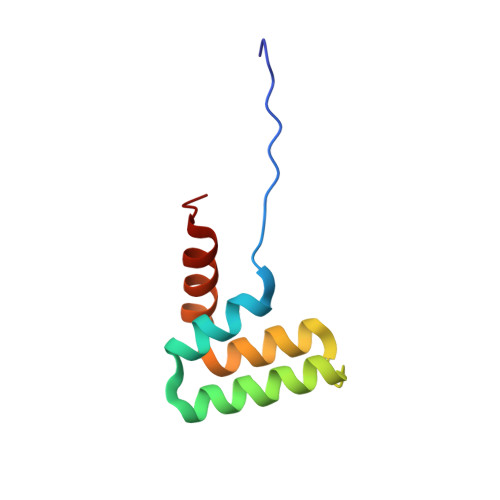alpha alpha-hub coregulator structure and flexibility determine transcription factor binding and selection in regulatory interactomes.
Friis Theisen, F., Salladini, E., Davidsen, R., Jo Rasmussen, C., Staby, L., Kragelund, B.B., Skriver, K.(2022) J Biological Chem 298: 101963-101963
- PubMed: 35452682
- DOI: https://doi.org/10.1016/j.jbc.2022.101963
- Primary Citation of Related Structures:
7AC1 - PubMed Abstract:
Formation of transcription factor (TF)-coregulator complexes is a key step in transcriptional regulation, with coregulators having essential functions as hub nodes in molecular networks. How specificity and selectivity are maintained in these nodes remain open questions. In this work, we addressed specificity in transcriptional networks using complexes formed between TFs and αα-hubs, which are defined by a common αα-hairpin secondary structure motif, as a model. Using NMR spectroscopy and binding thermodynamics, we analyzed the structure, dynamics, stability, and ligand-binding properties of the Arabidopsis thaliana RST domains from TAF4 and known binding partner RCD1, and the TAFH domain from human TAF4, allowing comparison across species, functions, and architectural contexts. While these αα-hubs shared the αα-hairpin motif, they differed in length and orientation of accessory helices as well as in their thermodynamic profiles of ligand binding. Whereas biologically relevant RCD1-ligand pairs displayed high affinity driven by enthalpy, TAF4-ligand interactions were entropy driven and exhibited less binding-induced structuring. We in addition identified a thermal unfolding state with a structured core for all three domains, although the temperature sensitivity differed. Thermal stability studies suggested that initial unfolding of the RCD1-RST domain localized around helix 1, lending this region structural malleability, while effects in TAF4-RST were more stochastic, suggesting variability in structural adaptability upon binding. Collectively, our results support a model in which hub structure, flexibility, and binding thermodynamics contribute to αα-hub-TF binding specificity, a finding of general relevance to the understanding of coregulator-ligand interactions and interactome sizes.
- REPIN and the Linderstrøm-Lang Centre for Protein Science, Department of Biology, University of Copenhagen, Copenhagen, Denmark.
Organizational Affiliation:
















